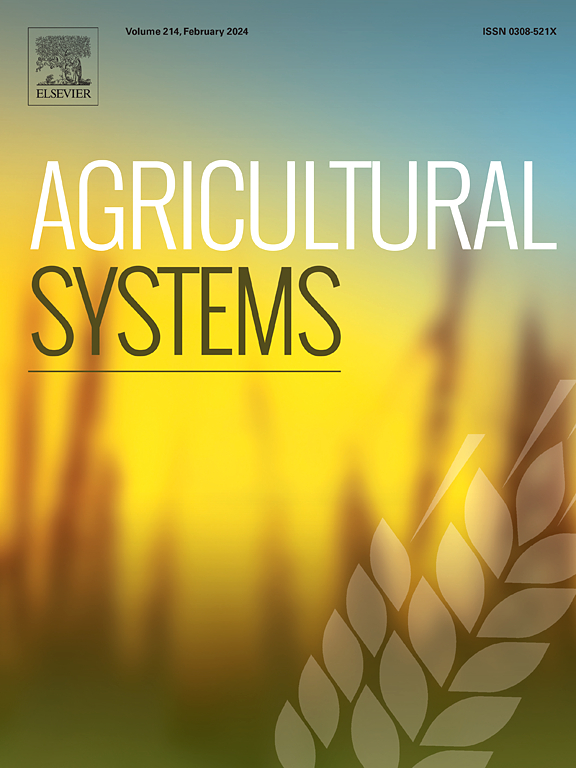农业系统中环境成本的适应性:与养分管理和不同农业实践的综合绩效相关的成本评估
IF 6.1
1区 农林科学
Q1 AGRICULTURE, MULTIDISCIPLINARY
引用次数: 0
摘要
农业生产造成的环境破坏已引起全球关注。在实践中,环境成本是农业生产的经济措施和环境措施之间的桥梁。然而,现有的关于环境损害经济价值量化的研究并不充分,这给利益相关者准确、可靠地评估环境损害的经济价值带来了困难。目的设计一个具有农业系统适应性的评价框架,以评价不同农业实践(ap)的生态效益,赋予其在农业系统中的适应性,并分析其对ap绩效的影响。方法设计生态效益评价框架,采用污染修复成本法计算不同ap的生态效益。通过问卷调查和参与式农村评估收集经济成本和效益数据。然后进行了成本效益分析,以评估不同ap的经济绩效,并检查EC对经济的影响。结果与结论溧阳地区10种有机磷农药中,茶叶、虾等品种(1万~ 1.7万元ha−1年−1年−1年)的生态效益显著大于传统有机磷农药(水稻/小麦等品种(900 ~ 8000元ha−1年−1年)的生态效益。当不考虑EC时,不同ap的现金收入显示为tea >;虾比;大米/虾比;水稻、油菜籽祝辞水稻/小麦比;水稻/绿肥>;大米比;油菜籽的在栗比;小麦。在加入EC后,茶叶和虾的EC削弱了它们在回报方面的优势。因此,电子商务在农艺决策中的作用不容忽视。意义本工作为农业系统EC的定量分析提供了参考方法。生态环境评价为政策制定者制定环境政策和农业经营者制定农业发展战略提供了科学依据。这将有助于平衡经济利益与环境保护之间的关系,并将推动农业系统生态补偿的合理量化。本文章由计算机程序翻译,如有差异,请以英文原文为准。

Adaptability of environmental costs in agricultural systems: Evaluation of costs associated with nutrient management and comprehensive performance of different agricultural practices
CONTEXT
Environmental damage due to agricultural production has raised global concern. In practice, environmental costs (EC) serve as a bridge between economic and environmental measures of agricultural production. However, existing research on quantifying EC is inadequate resulting in trouble for stakeholders to evaluate the economic value of environmental damages accurately and reliably.
OBJECTIVE
This work aimed to design an evaluation framework with agricultural system adaptability for evaluating the EC of different agricultural practices (APs) while conferring their adaptability in agricultural systems and analyzing their impact on the performance of APs.
METHODS
We designed an EC evaluation framework and calculated the EC of different APs using the pollution restoration cost method. Economic cost and benefit data were gathered through questionnaires and participatory rural appraisals. A cost-benefit analysis was then conducted to evaluate the economic performance of different APs and to examine the impact of EC on the economy.
RESULTS AND CONCLUSION
The results showed that among the 10 APs in Liyang, the EC of specialized APs (tea, shrimp, etc., 10,000 to 17,000 CNY ha−1 yr−1) were significantly larger than those of the traditional APs (rice/wheat, etc., 900 to 8000 CNY ha−1 yr−1). When EC was not considered, the cash income of different APs were shown as tea > shrimp > rice/shrimp > rice/rapeseed > rice/wheat > rice/green manure > rice > rapeseed > chestnut > wheat. After incorporating the EC, the EC of the tea and shrimp weakened their advantages in terms of returns. Therefore, the role of EC in agronomic decision-making cannot be ignored.
SIGNIFICANCE
This work provided a reference method for quantifying EC in agricultural systems. The evaluation of EC provided a scientific basis for policymakers to formulate environmental policies and for agricultural operators to formulate agricultural development strategies. It will contribute to striking a balance between economic interests and environmental protection, and will advance the rational quantification of ecological compensation in agricultural systems.
求助全文
通过发布文献求助,成功后即可免费获取论文全文。
去求助
来源期刊

Agricultural Systems
农林科学-农业综合
CiteScore
13.30
自引率
7.60%
发文量
174
审稿时长
30 days
期刊介绍:
Agricultural Systems is an international journal that deals with interactions - among the components of agricultural systems, among hierarchical levels of agricultural systems, between agricultural and other land use systems, and between agricultural systems and their natural, social and economic environments.
The scope includes the development and application of systems analysis methodologies in the following areas:
Systems approaches in the sustainable intensification of agriculture; pathways for sustainable intensification; crop-livestock integration; farm-level resource allocation; quantification of benefits and trade-offs at farm to landscape levels; integrative, participatory and dynamic modelling approaches for qualitative and quantitative assessments of agricultural systems and decision making;
The interactions between agricultural and non-agricultural landscapes; the multiple services of agricultural systems; food security and the environment;
Global change and adaptation science; transformational adaptations as driven by changes in climate, policy, values and attitudes influencing the design of farming systems;
Development and application of farming systems design tools and methods for impact, scenario and case study analysis; managing the complexities of dynamic agricultural systems; innovation systems and multi stakeholder arrangements that support or promote change and (or) inform policy decisions.
 求助内容:
求助内容: 应助结果提醒方式:
应助结果提醒方式:


